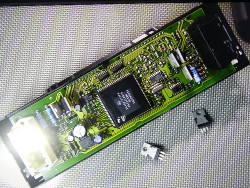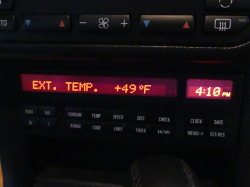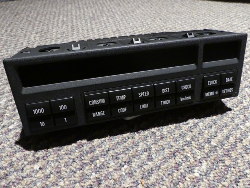Sunday, December 4, 2016
OBC Repair Attempt: Take 2
Back in May 2015 I noticed that the backlight of the OBC information display became somewhat dimmer than the clock display and then would occasionally turn off entirely. At that time I determined that the problem was strictly related to the backlight circuit and not a microcontroller fault or LCD driver problem. The test was simple: I shined a bright light at the display and that allowed me to verify that the display segments continued to operate and change in response to button presses.
Thinking this was a simple matter of failed FETs that are used to switch the lighting circuit on and off (presumably as part of a PWM circuit driven by the microcontroller) I sourced some new-old-stock FETs and replaced the first of the three devices I thought might be responsible. I could have replaced all three at that time but I wanted to localize the failure so I could give better guidance on the repair.
Not long after I conducted that repair I figured out that it hadn't fixed the problem though it did seem to cause the symptoms to occur less frequently. In fact, I hadn't thought about the issue until this week when the display went out and refused to return to service even over several drive cycles. So last weekend I decided to pull the OBC and replace the remaining two devices. Just before I removed the unit I gave it a few slaps and played with the connectors to ensure the problem was not due to a poor electrical connection. Sure enough, the display remained inoperative. Consistency in essential while troubleshooting so I was actually happy with this result.
 Once again I put the original 18 year old OBC on the bench in a last ditch effort to save myself the cost of a new unit. Viewed through my company's Tagarno microscope which is connected to a HD monitor. FETs (TO-220 package) allow the 5V microcontroller I/O to switch the 12V lamp circuit. |
 After the repair and the unit reinstalled the vehicle a turn of the key revealed a consistent symptom of the problem -- the main display is noticeably dimmer than the clock display. The brightness eventually declines and wavers a bit before failing entirely in a few minutes. |
 I was not successful in saving the original unit so I figured I'd get a new unit while they are still available. BMW is no longer accepting cores, which means they're no longer remanufacturing them, so when they're gone, they're gone. Get yours while you still can. |
I brought the unit to the bench and leveraged my rework and inspection equipment to desolder the old devices and install the new ones. I reinstalled the unit in the car and experienced some improvement -- the display was working again -- but my hopes were dashed when I realized the main display was dimmer than the clock display as I had noted previously. And while out on a drive later that night I noticed the display grow dimmer over a period of minutes and then waver a bit before going out entirely again. This proved that the problem was not related to the three FETs I replaced.
Lacking any real engineering data on the unit and with no other ideas on how to fix the problem I came to the unfortunate conclusion that I needed a new OBC. A quick call to my parts department revealed that the OBC was still available so in spite of the cost I decided to order one for several reasons. First and most obviously, it would provide a quick and easy fix to the problem plaguing my existing unit. Second, it would provide a new keypad assembly to replace my cosmetically and mechanically worn parts. And finally, as BMW no longer requires a core charge on these units there is no (avoidable) penalty for keeping my old unit. This should allow its use as a development host for the OpenOBC Project or an equivalent I might develop using the full complement of hardware design tools and experience I now have at my disposal.
The unit arrived yesterday, about a week ahead of schedule, but as it comes uncoded I'll have to wrangle my tech sometime soon to program the unit.
Cluster LCD Segment Issue and Availability
Speaking of failing electronics modules, for the past several years I've noticed some of the segments in the odometer LCD have been intermittent. I've also noticed since about my fourth year of ownership that the overlay has pulled away from the backlight substrate, creating mild changes in backlighting intensity across the dial faces. In my quest for a quick fix for these problems, while ordering the OBC I asked my parts rep if the clusters were still available. The initial response was that the part was backordered but a few days later confirmation came from Germany -- the cluster is officially no longer available.
I've had to deal with my share of discontinued parts in this car, particularly over the last few years, but this really gave me pause. It's one thing to discontinue some generic mechanical or cosmetic component, as with enough time and demand it's fair to say that the aftermarket could likely produce a replacement part, much as GAHH did for my recent leather replacement project. But vehicle electronics are another story entirely. As someone who has made a career in embedded systems I can say with high confidence that no company other than BMW could afford to produce a functionally equivalent (not to mention, certified) replacement gauge cluster for this car. Hence I find laughable BMW's official reply to my parts request "Unfortunately, PN 8379819 is no longer available. Germany has advised to source aftermarket or repair for replacement."
Of course this is nothing new under the sun -- every car produced in the last 30 years is a ticking time bomb of electronics technology -- but I would expect a premium auto manufacturer like BMW to take a different approach and either provide newly engineered replacement parts (as BMW often does...just not in this case) or release full engineering documentation for parts they no longer wish to support so the aftermarket would have a shot at repair or replacement at the component or board level. Sadly, however, this is not the case and likely never will be without regulation.
The good news in my case is the LCD segment problem is mostly an issue of cosmetics and should be relatively easy to fix. If the problem is simply due to a faulty connection between the PCB and the LCD display module, reflowing the joints should fix the issue as it has for many people. If the issue is with the LCD module itself, I may still be able to salvage one from an otherwise broken cluster. As for the variation in backlight intensity, the only way I know to fix the problem is to completely dismantle the front half of the cluster and use a special glue (apparently made by 3M) that would allow me to re-fasten the overlay to the substrate. I remember reading a thread somewhere years ago about someone doing exactly this but I haven't been able to find it again.
Winter Tire Swap
I love the way this car drives with the 17 inch M-Contour wheels and Pilot Super Sport rubber. As Ferris would say, "it is so choice!". So I can't be blamed for procrastinating more than usual on my winter tire swap. With several inches of snow forecast to arrive within the week, however, I decided it was time to get down to business.
If there is any downside to the Winter Sport 4D it is that the tread pattern tends to pick up small stones so I naturally spent about 10 minutes inspecting the treads and picking out the debris embedded in the sipes. Some of the smaller stones took on the appearance of nails with the heads worn off but I'm happy to say I found no nails or other permanent tread damage.
Pulling out of the driveway on my way home I once again realized how much I like the driving dynamics of the Winter Sport 4D. As I've said before, like any winter-focused tire it sacrifices some steering accuracy and dynamic stability (during, for example, rapid lane changes) but this is more than offset by the improved acceleration and braking performance made possible by the smaller and lighter wheels and tires. I actually have to be careful accelerating around turns with these tires because it's quite possible to break traction. Imagine how much faster the new M2 would be it wasn't hauling around those ridiculous 19 inch wheels and 15 inch rotors!
The tread on the rear tires is noticeably more worn than the front, but that's to be expected given how easy it is to break traction. I have noticed a bit more wear in the center portion as well, which I attribute to a slight overinflation. I typically run 33 pounds at all four corners but some reduction in pressure may be warranted on the next set. On the front tires I've noticed the wear is nicely consistent across the tread and the shoulders are not worn as much I would have expected. I attribute this to both a proper alignment (no bent control arms, etc.) as well as the fact that I'm running about half the factory spec for toe-in so the tires aren't scrubbing as much.
I'm pretty confident that the tires will get me through this season but wear on the rears may warrant replacement prior to the 2017/2018 season.
Mileage: 264800



